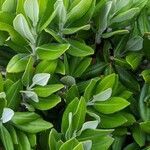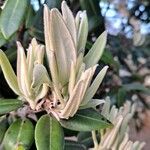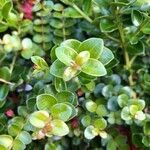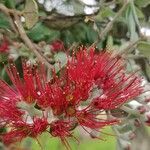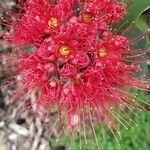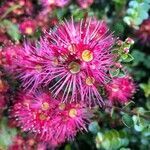Tree up to 20 m. tall; trunk up to 2 m. diam.; branches spreading; branchlets stout, tomentose. Lvs on short stout petioles; lamina (2.5)-5-10 × 2.5-3-5 cm., elliptic to oblong, acute or obtuse, coriac., thick, clad in white tomentum below (young plants occ. glab. below). Infl. of broad compound cymes with ∞ fls; pedicels stout, tomentose. Receptacle obconic; sepals deltoid; petals crimson, oblong. Stamens ∞, crimson, 3-4 cm. long. Ovary adnate to receptacle. Capsules 7-9 mm. long, tomentose, distinctly exserted, loculicidally 3-valved.
Tree to 21 m with short thick trunk to 1.5 m diameter.. Leaves lanceolate to oblong, 2.5–10 cm long, 1–5.2 cm wide, obtuse or acute at the apex, thick, usually tomentose beneath.. Flowers dark crimson in many-flowered terminal cymes with stamens 3–3.8 cm long and calyx and pedicels densely grey tomentose.
A tree. It is wide spreading. The leaves are round and leathery. The flowers are large.
